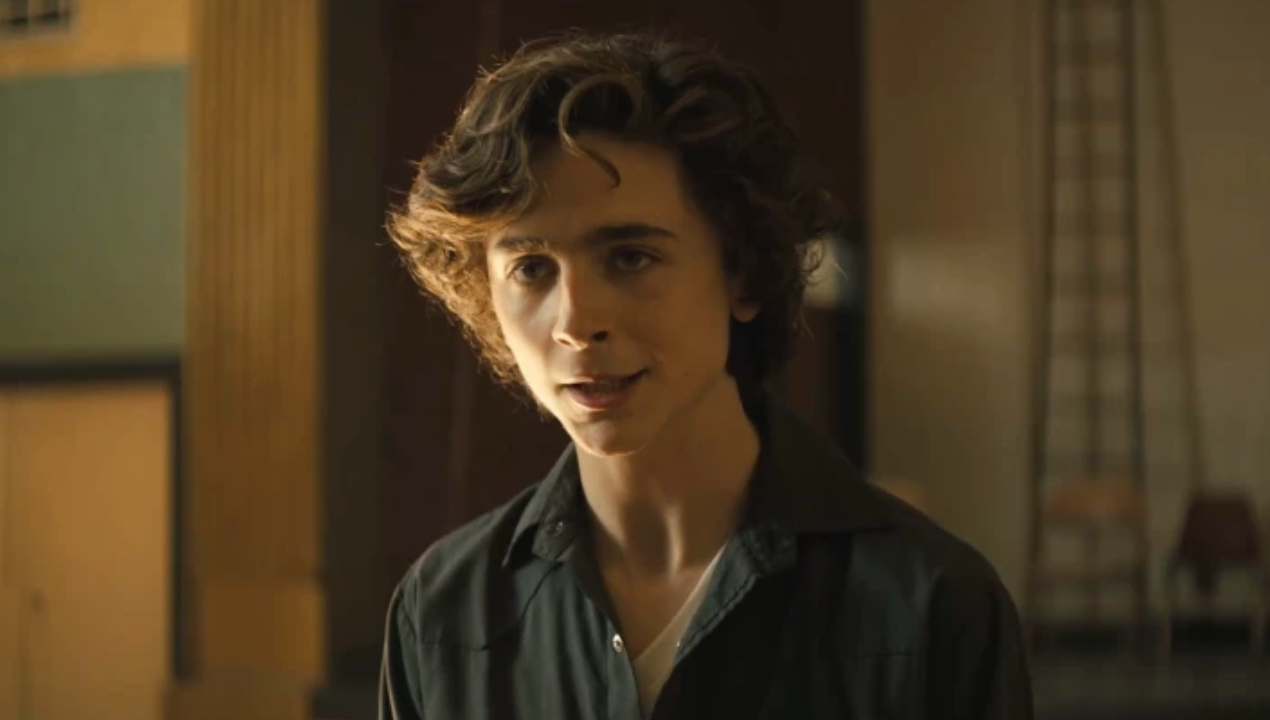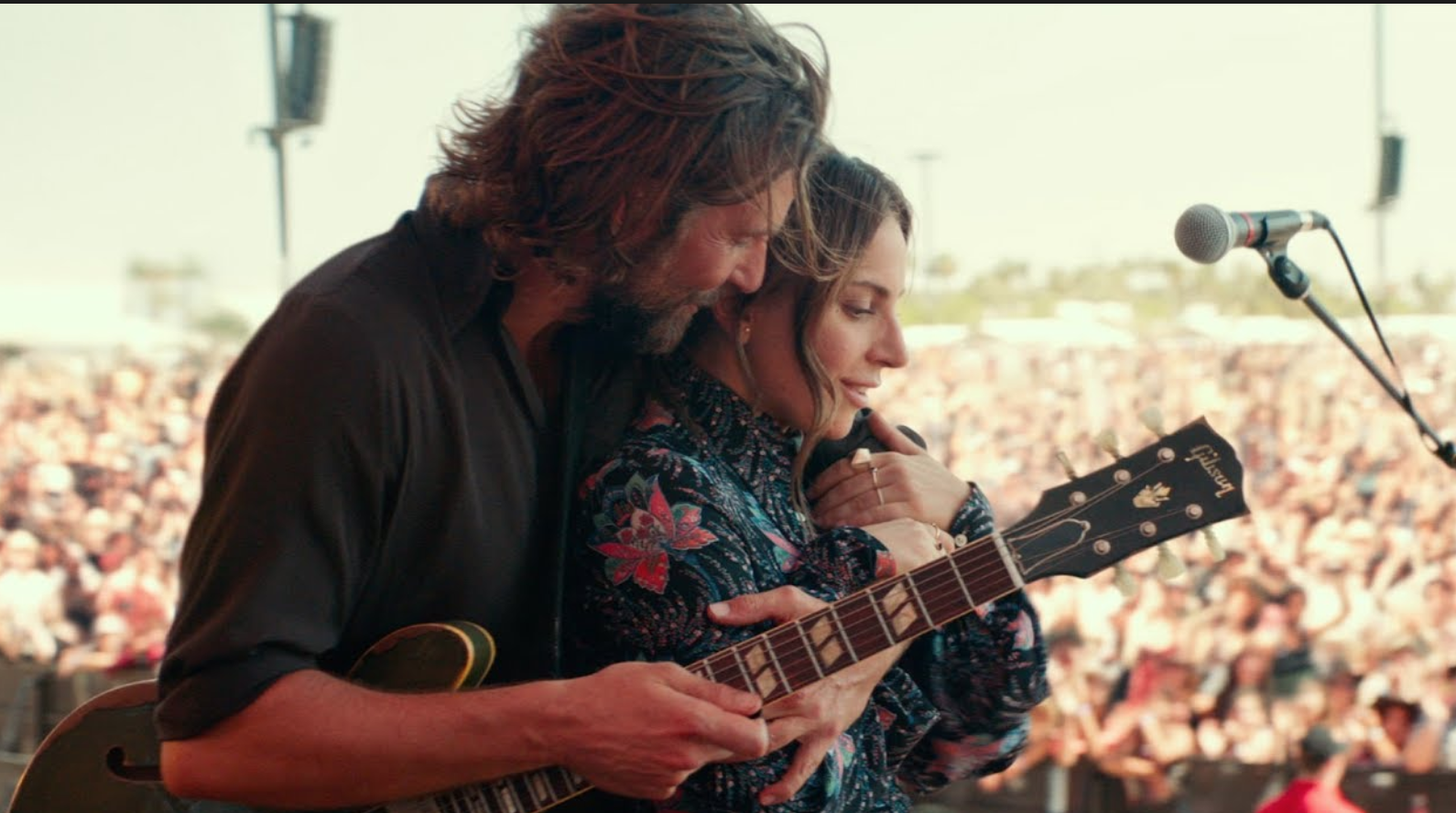I’m starting late, but today’s schedule includes (a) a hotel-room interview with director Nadine Labaki, whose brilliant Capernaum (showing at TIFF) everyone flipped over in Cannes four months ago; (b) a 4 pm screening of Paul Greengrass‘s 22 July at the Elgin, (c) the big Sony Classics dinner at Morton’s, and (d) a 9:30 pm screening of Steve McQueen‘s Widows at Roy Thomson Hall. Update: The Labaki interview will happen during the Morton’s dinner.
Daily
Trailer Doesn’t Change Matters
As mesmerizing and swan-divey as Carey Mulligan is in Paul Dano‘s Wildlife, there’s no forgiving her character for boinking the Uriah Heep-like Bill Camp. I’m sorry but that’s a shutdown, an unforgivable; ditto her perverse decision to almost invite her son Joe (Ed Oxenbould) to participate in this infidelity.
For the fourth or fifth time, my Sundance ’18 review: Paul Dano‘s Wildlife is a sluggish but otherwise strongly directed middle-class horror film — cold, creepy, perverse. I didn’t hate it because of Dano’s visual discipline (handsome compositions, a restrained shooting style, extra-scrupulous 1960 period design) and because of Carey Mulligan‘s fascinating performance as a youngish cheating mom in a small Montana town. But it’s a funereal gloom movie, and it makes you feel like you’re sinking into a cold swamp.
On top of which I was appalled — astonished — by the cruel, self-destructive behavior of this sad 34 year-old woman, whose name is Jeanette, and particularly by her decision to invite her 14 year-old son Joe (Ed Oxenbould) to almost participate in some extra-marital humping with a rich, small-town fat guy (Bill Camp) while her irresponsible husband Jerry (Jake Gyllenhaal) is off fighting a forest fire with local volunteers.
Bread and Circuses
One question: what took him so long? What lofty goal was Barack Obama serving by being silent for the last 19 and 1/2 months?
Dead Movie
I’m sorry but Felix Van Groeningen‘s Beautiful Boy (Amazon, 10.12) just lies there. It does a good job of pretending to be alive and human as far as the drug-addiction genre allows, but it has no pulse, no campfire-tale hook, no currents that pull you along.
Based on a pair of best-selling memoirs by journalist David Sheff and his son Nic, Beautiful Boy is a sensitive, well-intentioned, steady-as-she-goes saga of meth addiction. But the decision to tell the tale from the elder Sheff’s perspective, or that of Steve Carell‘s mopey-dope performance, was lethal. Because Carell is boredom personified here; ditto the other grim-faced adult characters played by Maura Tierney, Amy Ryan, Timothy Hutton, etc.
The only thing that could have saved Beautiful Boy would have been to shift the POV to Timothy Chalamet‘s Nic — to follow the lead of Otto Preminger‘s The Man With The Golden Arm by sinking into Nic’s secret subterranean life of copping, shooting, evasions, lying, low-downing and evading the law, etc. As is, the camera rarely buddies up with Nic and his girlfriend Lauren (Kaitlyn Dever) and their scumbag pallies, and the sense of fatigue that comes from hanging with dull-as-dishwater Carell becomes oppressive. And then numbing.
I was inwardly screaming last night as I sat in my balcony seat alongside Dave Karger and several other journos. HE mantra: “I’m dying…I’m sinking into boredom quicksand.”
Who thought that making a movie out of these books would be a good idea? This movie is going to expire and disappear so quickly it won’t be funny. Dead, dead, deader than dead.
Yes, Chalamet (whom I ran into at the Soho House after-party…”yo, bruh!”) is very convincing as Nic — he’s a highly skilled and charismatic actor who digs right in — but all you can feel as you’re watching the poor guy is pity. Because he’s trapped in a dull movie, and the only thing that can save him in this context is for the movie to fucking end.
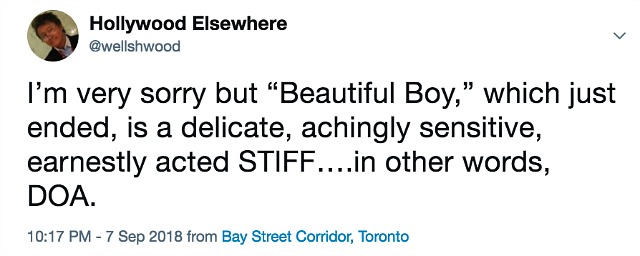
Carefully Phrased
For those who aren’t in Toronto right now: You need to process Twitter reactions to A Star Is Born from a certain cultural perspective. I’ve been told that what I’m about to imply could get me into trouble so I’m going to step lightly here. I think we all understand there are certain persons out there who are totally into musicals, and who are extra-totally in the tank for all things Lady Gaga. Just as I am admittedly in the tank for all things Roma and Alfonso Cuaron as well as First Man, Cold War, Capernaum, First Reformed and possibly Green Book. Just as First Showing‘s Alex Billington is in the tank for almost every geek-fanboy movie that comes along and Collider‘s Jeff Sneider is in the tank for David Gordon Green‘s Halloween sequel. We all have certain aesthetic flavors and emotional persuasions that we enjoy diving into and identifying with and prioritizing.
It’s therefore fair to acknowledge that here in Toronto there was a certain Star Is Born cult ready and waiting to leap into the air and throw confetti before the first press screening. I’m not saying there’s anything remotely unwelcome or uncool about this enthusiasm, but A Star Is Born does seem to have a kind of “in the tank” home team at the ready.
No need to make anything out of this except to repeat, as I’ve said in previous post and contexts, that you’d probably be wiser to listen to those who aren’t in the tank (i.e., persons like myself) than to those who are. Yesterday I called Bradley Cooper‘s tragi-musical a well-made, first-rate, heart-melting cheese casserole that will accumulate a few Oscar nominations, including Best Picture. Within the realm of what A Star Is Born is and despite what Steven Gaydos may tweet, that’s high praise indeed. And you can take that to the bank.

Who Spells “Mama” With Three Ems?
Last night I was waiting in line at Rabba Foods, a deli-like store at the corner of Simcoe and Nelson. I was holding a few items, including two plastic cups of granola, fruit and vanilla yogurt. Waiting, waiting…and then I heard a kind of pop sound, like a small balloon exploding. I ignored it. Finally it was my turn and I put my stuff on on the counter, and realized that one of my yogurts was missing. I turned around and saw a white granola-fruit blob on the linoleum floor. Aahh, that was the small exploding sound!…me, my yogurt, my error, apologies. Nobody rushed over to clean it up. The blob just sat there like an object d’art.

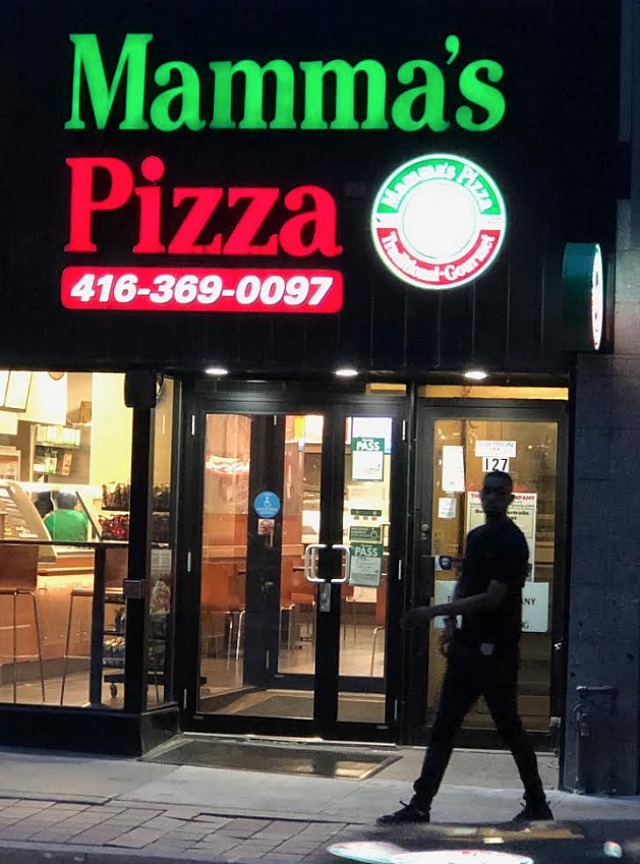
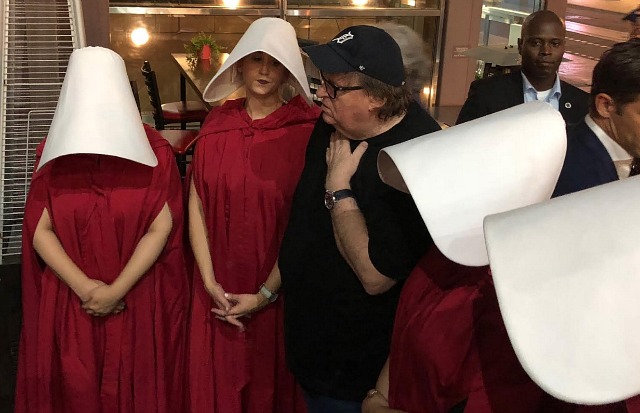
Michael Moore and handmaidens during the Fahrenheit 11/9 after-party at at Speak Easy.
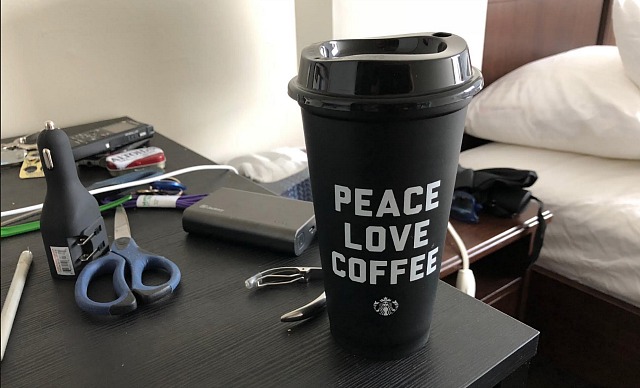
Lowest of the Low?
Even I was unnerved — okay, scared — by the appearance of that evil, banshee-like, black-eyed nun in the last Conjuring movie I saw. But when it come to The Nun, the just-opened spin-off, it seemed inevitable that it would be sludge. I sensed that intuitively before checking out the Rotten Tomatoes and Metacritic scores (respectively 29% and 46%). But I haven’t seen it (Telluride and Toronto deluge) so please, if there’s anything half-good about The Nun that requires a brief mention, please share. A few HE community members must have seen it.
Run-Around
Arrived at 8:30 this morning at Bell Lightbox for the 9:15 press screening of A Star Is Born. Hit press lounge (good wifi, free food, decent free coffee) at 11:30 am to write review. Attended 2 pm screening of Nadine Labaki’s Capernaum and then, for old time’s sake, an hour’s worth of Pawel Pawlikowski‘s Cold War. Currently catching Hotel Mumbai at Princess of Wales theatre. Final diversion will be an 8 pm Elgin screening of Beautiful Boy with a SoHo House party at 10 pm.
Guarded Respect for “A Star Is Born”
I have an hour to tap out reactions to Bradley Cooper‘s A Star Is Born before my next screening, and I have two basic things to say.
One, Variety‘s Kris Tapley oversold the situation three days ago when he wrote that the Warner Bros. release has “the muscle to win all five major Academy Awards (picture, director, actor, actress, and screenplay)…it’s that kind of accomplishment.” And two, Cooper’s version of this age-old tragic romance (this being the fourth version and the third remake) struck me, no lie, as the most engaging, least problematic, best acted and most skillfully assembled of them all.
That sounds like a contradiction, right? The most satisfying and well-tuned Star Is Born I’ve ever seen that’s nonetheless been over-hyped by a certain columnist?
What I mean is that Cooper’s film is the kind of ace-level production that will seem hugely impressive to Academy members who are pre-disposed to tumble for this kind of thing sight unseen, who love the idea of a swoony pop massage-weeper, and who aren’t cultured or hip enough to realize that as technically assured and emotionally affecting as A Star Is Born is, it’s still a rehash of an old romantic tale, and you just can’t call it crackling or new or reach-for-the-heavens in a 2018 sense. Well, you can try but it won’t sell.

Put another way, A Star Is Born can’t hope to sink into our souls or our anxious, Twitter-jitter, Trump-besieged ADD culture in a way that’s truly head-turning in a right-now way. At the end of the day it’s still a classic cheese casserole, still A Star Is Born, still the same basic sappy saga (alcoholic star launches fresh talent, sinks into worsening addiction, gets in her way, decides to off himself) that was shot and released in ’37, 54′ and ’76, blah blah.
It’ll be Best Picture-nominated for sure, but only the easy lays and none-too-hips are going to say “whoa, Tapley was sooo right!…this is not only the best film I’ve seen all year but it might win five Oscars!”
How good is Lady Gaga as Ally, the new Esther Blodgett? Pretty damn good, I’d say — she gives the kind of carefully measured, open-hearted performance that you can’t help but succumb to. For the first time since she became a major brand, I feel I know who Lady Gaga is deep down.
How good is Cooper as Jackson Maine, the 2018 version of Fredric March and James Mason‘s Norman Maine, not to mention the version played by Kris Kristofferson? Excellent — some have called it his best performance ever, although I have a special place in my heart for Cooper’s unstable, self-deluding protagonist in Silver Linings Playbook.
How good is the screenplay, which was co-written by Cooper, Eric Roth and Will Fetters? It’s very well honed, very believable, often eloquent, nicely understated. A pro-level job top to bottom.
So what am I saying? A Star Is Born is a very well-done musical drama, and will wind up being nominated in a few categories, but it’s not (to use a classic Steve Pond term) “the one.” It’s an expertly assembled film for what it is, but keep in mind that it’s basically big-studio schmalz of a very high, very hip and musically pleasing order.
Kris Tapley wasn’t wrong about a certain kind of Academy member falling for this film, but after everyone sees it they’ll need to step back and take a breath. They’ll need to look in the mirror and ask themselves, “Do I really think that a reconstituted high-end romantic tragedy that works all around the track as far as it goes…do I really think this is the absolute cat’s meow?” Some people will say “yes!” without thinking, but others will think twice.
Said it before, saying it again: everyone needs to calm the eff down.
What grade am I giving A Star Is Born? Somewhere between an A-minus and a B-plus. It’s very good but it’s a remake that throbs with wall-to-wall music, for God’s sake. Control yourselves.
A journalist colleague said last night that “people tend to over-estimate musicals…they don’t often play across the board…they touch people who want to be touched by them, but that’s not everybody.”
Moore Slams Trump Big-Time, But Also The Clintons
Michael Moore‘s Fahrenheit 11/9, which screened Thursday evening at the Toronto Film Festival, slices and dices Donald Trump in rousing, unequivocal, almost joyful fashion. And I loved it for that. Trump evisceration is what most ticket-buyers will expect to see, of course. And yet this complex, tough-minded doc drills into Trump for only about 1/3 of its running time. Okay, maybe 40%.
Orange Cheeto, it turns out, isn’t the primary villain of Fahrenheit 11/9 as much as the ultimate demonic expression of a general climate of corrosion, corruption and (this is interesting) laissez-faire, moderation-favoring attitudes among complacent Democratic normalists and media types over the last quarter-century.
Bill and Hillary Clinton are portrayed as the principal causes of a general lack of trust and proliferation of cynicism among the body politic about mainstream liberal governance. The mainstream media is culpable also, Moore says. He also champions the hardcore, anti-corporate left (Alexandria Ocasio Cortez, David Hogg and the other activist Parkland massacre survivors, the legendary Bernie Sanders). And a good portion of the doc focuses on the mind-boggling, all-but-deliberate poisoning of Flint, Michigan’s water supply.
The doc basically says that Trump is a malignant force and a lying, blustering, Hitler-esque authoritarian, but the political system is full of enablers, and we all have to get real and throw these bums out and stand with the gutsy activist lefties of the moment and make this country into a semblance of an actual Democracy again….no more Obama-styled “hope” but action, action and more action, and no more half-measures or liberal pussyfooting.
Moore’s ties to the working-class people of Michigan have always been his ace in the hole in terms of political-cultural insight and humanistic compassion. He was raised in the Flint suburb of Davison. In Moore’s youth Flint’s economy and General Motors factories were closely intertwined. His uncle LaVerne was one of the founders of the United Automobile Workers labor union and participated in the Flint Sit-Down Strike of 1936 and ’37.
Moore knows, of course, that much if not most of Trump’s support is rooted in demagoguery — in his skillful manipulation of racial resentments and anti-blue-state animus among the bumblefucks. Moore knows full well that racism is part of the mix, but he doesn’t touch it in Fahrenheit 11/9. He doesn’t want to pick at that ugly scab. But it’s obviously there, and the film would have been that much better if Moore had dealt with it to some extent.
How popular or influential will Fahrenheit 11/9 prove to be in terms of the upcoming midterm elections? It’ll help some, but the U.S. is a different culture than the one Fahrenheit 9/11 blew away 14 years ago.
Pig-Eyed Man Who Lives In A Fear Bubble
I know the Brett Kavanaugh handshake blowoff moment happened a couple of days ago, but I can’t get over the look of complete terror on the Supreme Court nominee’s face. All he seemed to sense was that the guy who wanted to shake his hand (i.e., Fred Guttenberg, father of Parkland shooting victim Jaime Guttenberg) wasn’t a Republican pally, and he freaked. “Aaaagghh!…it’s one of them!” Kavanaugh seemed to say to himself. Look at his face. What kind of reprehensible scumbag ignores a handshake reach-out? What did Kavanaugh think was going to happen? That Guttenberg might try to stab or shoot him?



